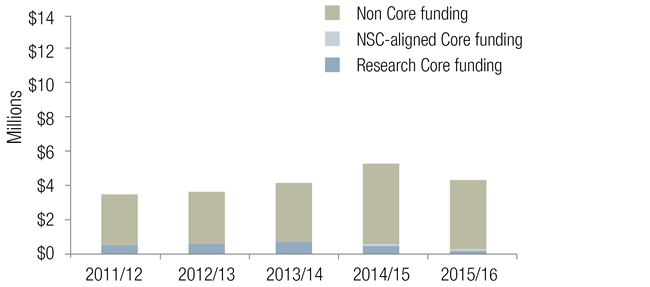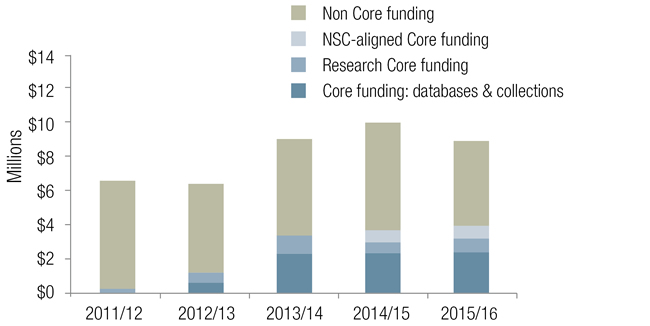National Outcome 4: Growth within Limits
Increase the ability of New Zealand industries and organisations to develop within environmental limits and meet market and community requirements
Background
New Zealand’s prosperity is heavily dependent on our environment. The prominence in our economy of primary sector production, tourism, and niche sectors reliant on our landscapes (e.g. the fi lm sector) highlight that, long term, New Zealand’s economic development can only be sustained by industries and sectors operating within complex environmental limits. This often entails balancing the diverse needs of multiple stakeholders, including government and local government, the private sector, Māori, and the community.
Our research supports agencies tasked with developing and implementing effective environmental policy, regulation, and practices for the sustainable management of land, water, and ecosystem services. Our work also supports MPI and the operational agencies tasked with managing biosecurity issues, and DOC, regional councils, and land managers responsible for weed and pest management. Research aligned to the BioHeritage Challenge will focus on high-tech, next-generation solutions to invasive small mammal surveillance and control. As the Predator Free New Zealand initiative gains profile, there is growing interest in the potentially significant contribution of citizen science projects, particularly at the landscape scale.
Impact 4.1: Factors (including the form of institutions) required to resolve complex environmental issues, adapt to global change, and reduce vulnerability to resource scarcity are understood and recognised
Core Funding Investment

Key Performance Indicator 4.1: Industry sectors and central and local government are making strategic use of research findings, associated indicators of performance, and new economic instruments to respond to complex environmental issues, global change processes, and resource scarcity
Core-funded progress for 2015/16 is reported in the achievements table, particularly under:
Highlights
Helping shape future environmental policy and regulation in New Zealand: A number of senior Landcare Research staff contributed to the 3rd OECD Environmental Performance Review of New Zealand, providing a range of science-based advice to inform this once-in-a-decade international review. The Ministers for the Environment and Primary Industries also invited Landcare Research’s Dr Suzie Greenhalgh onto the Ministerial Advisory Group on Water Allocation to develop options for the allocation of fresh water and discharges in New Zealand. These high-profile examples indicate the influence of Landcare Research staff on the future direction of natural resource management and conservation in New Zealand through provision of expert, authoritative, and independent advice on land and soils, biodiversity and ecosystems, and mātauranga. OECD Review Report recommendations often directly result in change to policy, management, and funding settings. The Ministerial Advisory Group will make recommendations to the incoming (post-election) government for decision late next year. This significant advisory role highlights the influence of our resource economics and policy-centred research on future policy and regulatory regimes in New Zealand.
Supporting Crown decisions on water rights: Using our NZFARM model, we analysed for MPI the impacts on iwi of various nutrient allocation options in the Hurunui catchment. The analysis was used to inform policy options being developed by the Crown for fresh water, particularly in respect of iwi. Our analysis clarified the impacts of various allocation options for senior Ministers and iwi leaders, including how the initial allocation of diffuse contaminant discharges can be made in a manner consistent with the Treaty of Waitangi while achieving the greatest economic value from freshwater resources.
Showing it can be done: Catchment-scale actions to improve water quality: We published the results from a major research initiative in the Ruamahanga catchment. A number of our primary sector clients are interested in the findings of our E. coli modelling in the Ruamāhanga catchment, which showed that the catchment-wide impact of riparian fencing, dairy effluent ponds, and dung beetles was dramatic, and that synergistic catchment-scale initiatives can deliver major water-quality gains.
Delivering a new approach to modelling pasture water status: We have developed a new way of modelling how pastures respond to water for DairyNZ. Our new approach expresses water availability as water potential, and we have shown that standard ryegrass clover mixtures are much more sensitive to declines in water potential than more diverse mixtures. This means diverse mixtures should require less water under irrigation to maintain production. Our model could be used to optimise allocation of standard and diverse mixtures at the farm or catchment scale to maintain production while minimising water requirements. There is potential for this work to be included in the modelling and decision-making tools provided by DairyNZ to the dairy industry.
Impact 4.2: Best solutions that integrate economic, social, cultural and environmental perspectives to maintain or enhance international competitiveness, market access and social licence for business and industry to operate
Core Funding Investment

Key Performance Indicator 4.2a: An industry sector (dairy, horticulture or energy) is using a framework for integrating economic, environmental, social and/or cultural drivers to meet community and/or market requirements
Core-funded progress for 2015/16 is reported in the achievements table, particularly under:
- Supporting Business and Policy
- Characterising Land Resources
- Managing Land and Water
- Mitigating Greenhouse Gases
Key Performance Indicator 4.2b: Bovine TB is eradicated from vector populations in two extensive and difficult forest areas
On 4 July 2016 OSPRI announced New Zealand had taken another step towards becoming TB-free, with nearly 1.6 million hectares of previously infected land being declared free of the disease since 2011.
Core-funded progress for 2015/16 is reported in the achievements table, particularly under:
Highlights
Kiwifruit vulnerability assessment: The commercial cultivation of kiwifruit in New Zealand is concentrated in a relatively small area of the North Island. Cultivation is economically significant and growing quickly. We developed a ‘bottom up’ assessment of vulnerability, with the findings suggesting that climate and markets are the main sources of exposure for growers, with sensitivity moderated by location. Growers employ mostly short-term, reactive adaptive strategies to manage climate exposure and sensitivity, but have less capacity to respond to market related stressors. This work demonstrates the need to move beyond current vulnerability assessments in New Zealand, to consider a broader range of the factors that contribute to vulnerability in our agricultural sectors. The industry is interested in the findings, and in potential further work on multiple stressors and impacts in the industry. Particularly valuable to the industry are qualitative vulnerability assessments that are spatially specific.
Optimising land use under irrigation: The growth of irrigation schemes enables agricultural intensification and change to more profitable land uses. However, along with economic benefits, irrigation can also lead to adverse environmental effects, such as increased nitrate leaching. Decision makers face the challenge of assessing potential land-use development options and comparing their advantages and disadvantages in the light of socioeconomic expectations and environmental limits. This work used our Land Use Management Support System (LUMASS) model to assess land-use development scenarios for two potential irrigation schemes in the Ruamāhanga catchment. There is much industry and Council interest in this work, which essentially spatially optimises land-use configuration in irrigation schemes to maximise economic gain and minimise the environmental footprint.
Economic benefits of ragwort biocontrol: We have published the first economic analysis for a weed biocontrol programme in New Zealand. It demonstrates the scale of the cost saving to NZ dairy farms from ragwort biocontrol (NZ$44 million a year in 2015), and the future gains (NZ$20 million a year) that will arise if the next agent (the plume moth) is successful. It also shows the enormous costs (NZ$8.6 billion in net present value) incurred as a result of rejecting the successful agent, the fl ea beetle, in the 1930s – costs the NZ dairy sector would have avoided if a small investment in quantitative field trials had been made.
Balancing possum control and surveillance: Optimising the best use of resources for possum control for TB eradication also requires guidance on the most effective balance between using resources for control operations (more costly) versus surveillance (less costly, but does not reduce possum numbers) in any particular context. We produced a modelling framework to underpin such decisions by TBfree Vector Control Managers to guide local disease eradication efforts.
Decrease of 97.5% in herd TB: Recent statistics from OSPRI demonstrate the major benefits of our possum control research for the New Zealand primary sector. Between 1994 and 2014, there was a 97.5% drop in the number of infected cattle and deer herds in New Zealand, primarily driven by wildlife vector control. During this period, Landcare Research was the pre-eminent provider of research to TBfree New Zealand, for both the fundamental design and operationalisation of such vector control.
